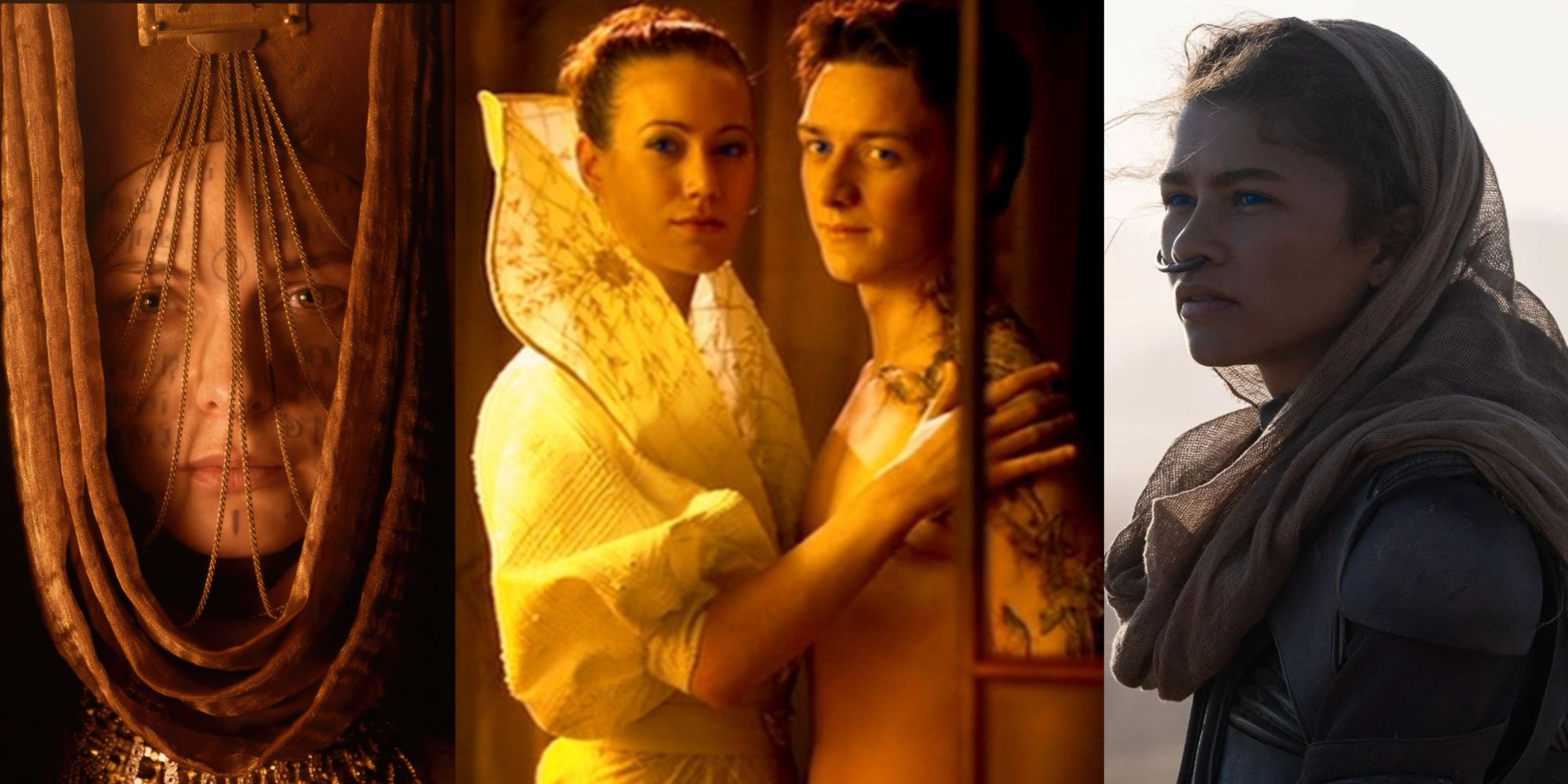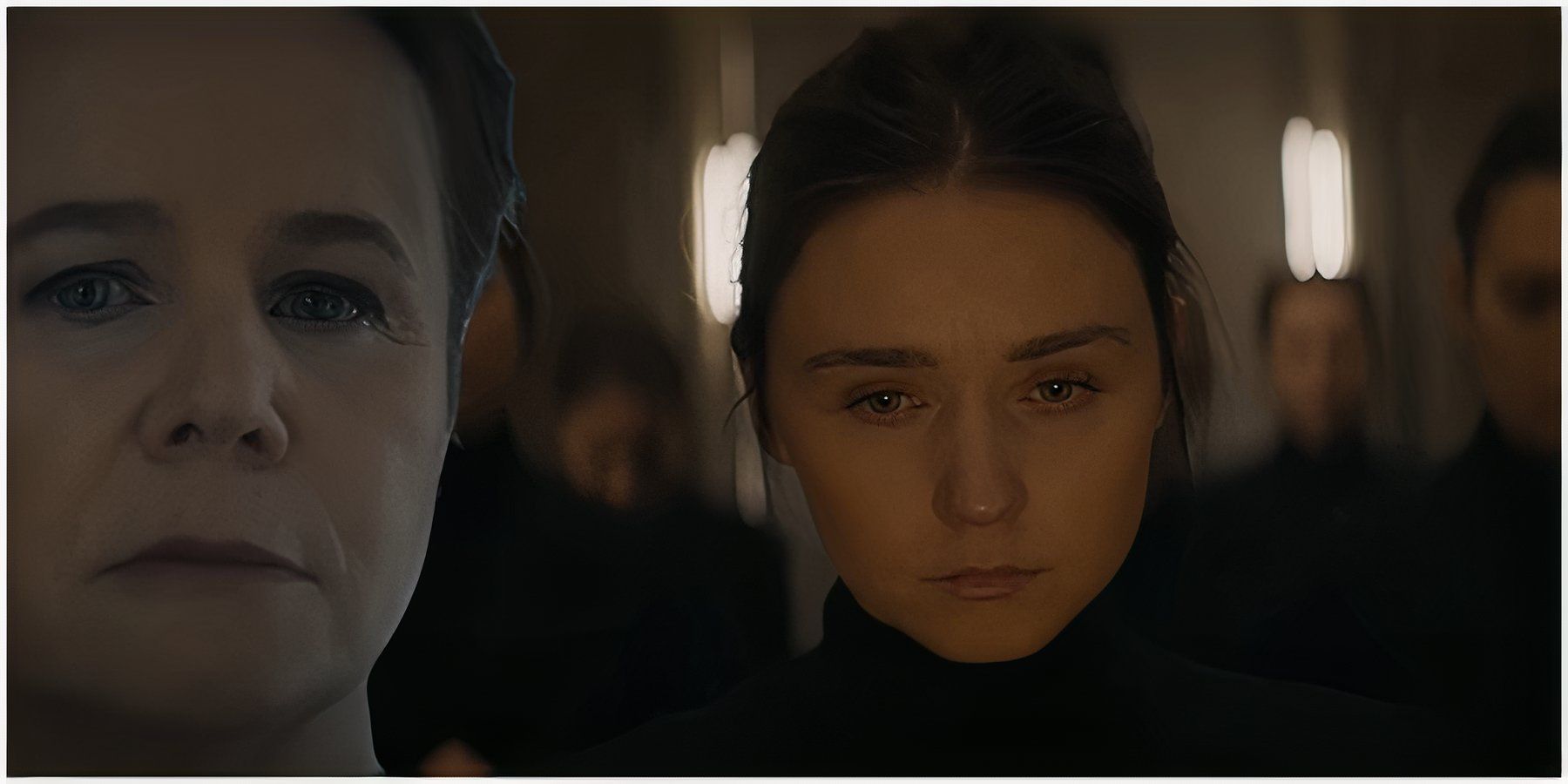
Quick Links
-
Dune: Prophecy And The Sisterhood
Key Takeaways
- Denis Villeneuve’s Dune covers Atreides massacre, Paul’s rise on Arrakis, and political maneuvering in the Imperium.
- HBO’s Dune: Prophecy will delve into the Bene Gesserit Sisterhood’s formation and the Harkonnen sisters’ quest for power.
- Valya Harkonnen is a key figure in Sisterhood of Dune, focusing on the rise of the Bene Gesserit and her rivalry with Vorian.
Denis Villeneuve’s two-part book-to-screen adaptation of Frank Herbert’s Dune covers the Atreides massacre at Castle Caladan, Paul Atreides and his mother, Lady Jessica of the Bene Gesserit’s escape into the desert, and the rise of Paul on Arrakis. Amid the political maneuvering in the Imperium, and the Harkonnen conspiracy, aided and abetted by the Emperor by providing his Sardaukar elite force, shadowy figures are seen working behind the scenes. They are the Bene Gesserit and a superior among them, Reverend Mother Gaius Helen Mohiam, chastises Lady Jessica, believing she threw a spanner in the works.
Besides Villeneuve’s saga, an original HBO drama series is on the way. It should pursue the formation and the formative years of the Sisterhood (the Bene Gesserit) in depth. Bene Gesserit’s mystique capture by Villeneuve in Dune warrants a tour back in time and come November 2024, Dune: Prophecy will shine a light on the two historic figures known as the Harkonnen sisters.
Related
What Is Dune: Prophecy Based On?
This Brian Herbert and Kevin J. Anderson novel inspired the HBO series, Dune: Prophecy.
Dune: Prophecy And The Sisterhood
Dune: Prophecy is based on Sisterhood of Dune (2012) by co-authors, Brian Herbert and the science fiction writer, Kevin J. Anderson. Herbert (the elder) died in 1986 and more than a decade later, Herbert Jr. and Anderson took the mantle of the Dune franchise authors. The duo mostly wrote a sequence of prequel trilogies, as well as two sequels, a graphic novel series, and a collection of short stories.
The prequel series’ title transition from “Dune: The Sisterhood” to “Dune: Prophecy” was made before the release of Dune: Part Two. This change aligned the series with the Dune franchise and attuned it to the central themes of the Chosen One prophecy, power, and politics in the Imperium, as well as the rich, complex, and intricate narrative of the Dune lore. It also enhanced the core themes of the second installment, as the birth and ascension of Paul Atreides and the fulfillment of the Kwisatz Haderach prophecy are significant to Dune lore.
Retitling the series to Dune: Prophecy is in accordance with the Bene Gesserit and Fremen prophecies of the Chosen One. The former foretells the arrival of a male Bene Gesserit/ a superbeing with access to male and female genetic memory, and extraordinary prescience. Closely associated with this prophecy is the Fremen belief that the messianic Lisan al-Gaib will deliver them from political and economic oppression that they meet at the hands of the Arrakis colonizers, i.e., the Harkonnens and the Imperium. The evil Harkonnens, permitted by the Emperor, ravage the Fremen planet for the highly valuable commodity, Spice Melange.
The decision to focus on the Bene Gesserit vis a vis the Imperium sounds like a natural progression in the Dune universe.
The Harkonnen Sisters
Who Are Valya And Tula Harkonnen?
The Harkonnen Sisters are at the core of Dune: Prophecy, with the logline stating that the series is set in Frank Herbert’s cosmos and explores their quest for power:
From the expansive universe of
Dune
, created by acclaimed author Frank Herbert, and 10,000 years before the ascension of Paul Atreides,
Dune: Prophecy
follows two Harkonnen sisters as they combat forces that threaten the future of humankind and establish the fabled sect that will become known as the Bene Gesserit.
Dune: Prophecy
is inspired by the novel
Sisterhood of Dune
, written by Brian Herbert and Kevin J. Anderson.
As the series delves into the history of the Bene Gesserit, it becomes pertinent to go over the life and times of Valya and Tula Harkonnen.
Emily Watson’s Valya Harkonnen is conspicuous in the teasers, while Tula takes her place as the co-lead or secondary protagonist. Valya’s younger iteration, portrayed by Jessica Amy Barden, richly contributes to the overall narrative. Ten thousand years before the coming of Paul Atreides to Arrakis, and his ascension, Valya played a key role in establishing an exclusive proto-religious sisterhood which later became the Bene Gesserit. It is pertinent to mention that the inspiration for the show (Herbert and Anderson’s Sisterhood of Dune) is set after the Butlerian Jihad, more specifically 80 years after the Battle of Corrin. In this post-war period, humanity is gradually recovering from the impact of an all-out war against the thinking machines. As such, the emergence of an exclusive sect, its development and early years, and the training of its acolytes to maximize their abilities through physical and mental conditioning (the Way) should be the focus of Dune: Prophecy.
Valya is a Harkonnen and arguably the most notable early figure in the Bene Gesserit Sisterhood. Valya dedicates her life to reforming and shaping the Sisterhood but fails to come to terms with House Harkonnen’s fall from grace because of her great-grandfather, Bashar Abulurd Harkonnen’s refusal to follow Supreme Bashar Vorian Atreides’ commands in the Battle of Corrin. At the end of the pivotal Butlerian Jihad, House Butler became House Corrino, and ruled the Known Universe, with various checks and balances in the Imperium. House Atreides gained prominence, while Valya and Tula’s ancestor fell from grace. Abulurd was exiled to the harsh backwater planet of Lankiveil. This planet is where his descendant, Valya, grew up to deeply hate the Atreides.
Valya grew up to become overly and unhealthily obsessed with the Atreides, the Harkonnens’ fall, and wanted to exact revenge. She passed down feelings of ill will, mistrust, and above all, hatred for Atreides to her younger sister, Tula, and their brother Griffin in her early years. Her later years were spent at the Sisterhood of Rossak, training under Mother Superior Raquella Berto-Anirul. After Emperor Salvador Corrino disbanded the Rossak Order by an Imperial decree, Valya went back to Lankiveil, as relentless as ever. With Raquella’s permission, she went to Ginaz to train as a Swordmaster in the following years. She also developed and perfected the Voice, while sister Tula followed her commands in letter and spirit.
Valya was among the 28 Raquella followers who went to Wallach IX to rebuild, reunite, and strengthen the Sisterhood. Following Mother Superior Raquella’s demise, Valya emerged as the sole Reverend Mother Superior by eliminating her chosen co-leader, Dorotea, using the Voice. She reshaped the Sisterhood upon her rise and gave it the name – the Bene Gesserit. The Bene Gesserit’s base of operations, i.e., the Mother School on Wallach IX, was established as Valya continued her rivalry with Vorian. Valya’s rise from a mere recruit at Rossak to the second Reverend Mother Superior of the Bene Gesserit is a testament to her dedication and abilities.
Tula is pressed on the matters by Valya in HBO’s Dune: Prophecy. Valya appears the more ferocious of the two Harkonnen sisters, while Tula is submissive. Tula is guilty of killing her husband Orry Atreides on their wedding night at Valya’s behest and continues to listen to the latter’s arguments in the Dune: Prophecy Official Teaser 2.

More
Dune 3: Things That Should Happen In The Movie Sequel
With confirmation of Dune Part 3 from director Denis Villeneuve, these the events from the Dune: Messiah book that should happen in the sequel.
